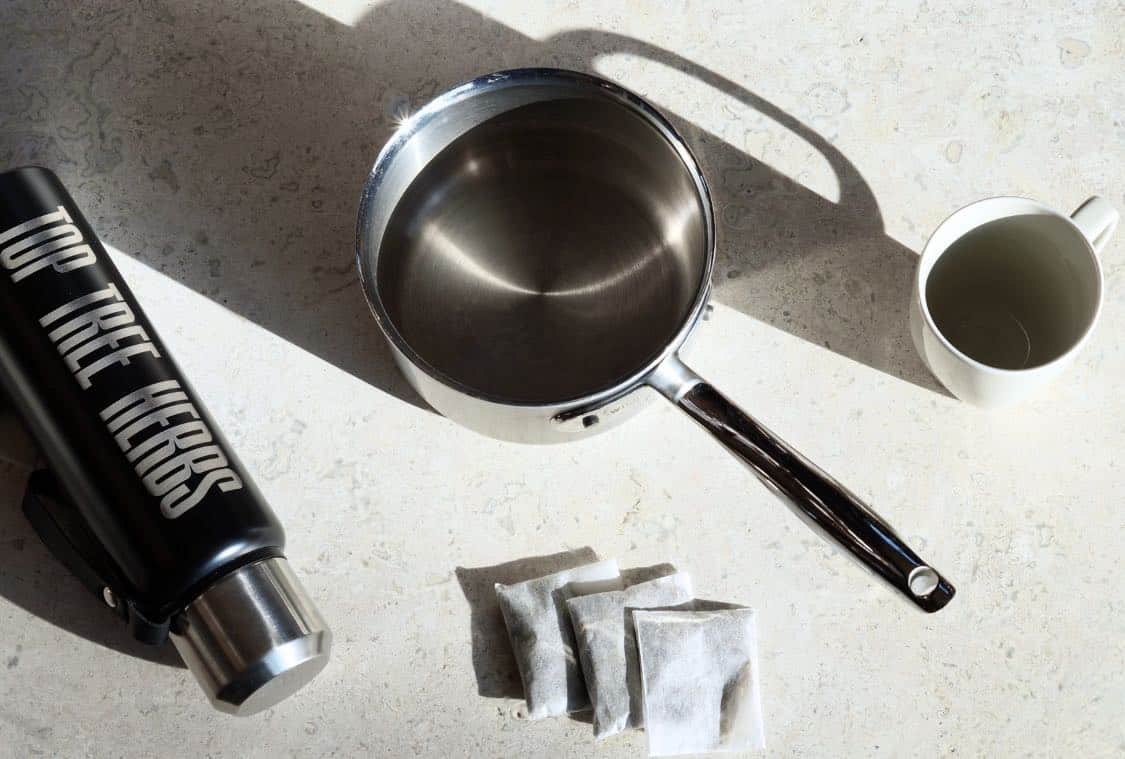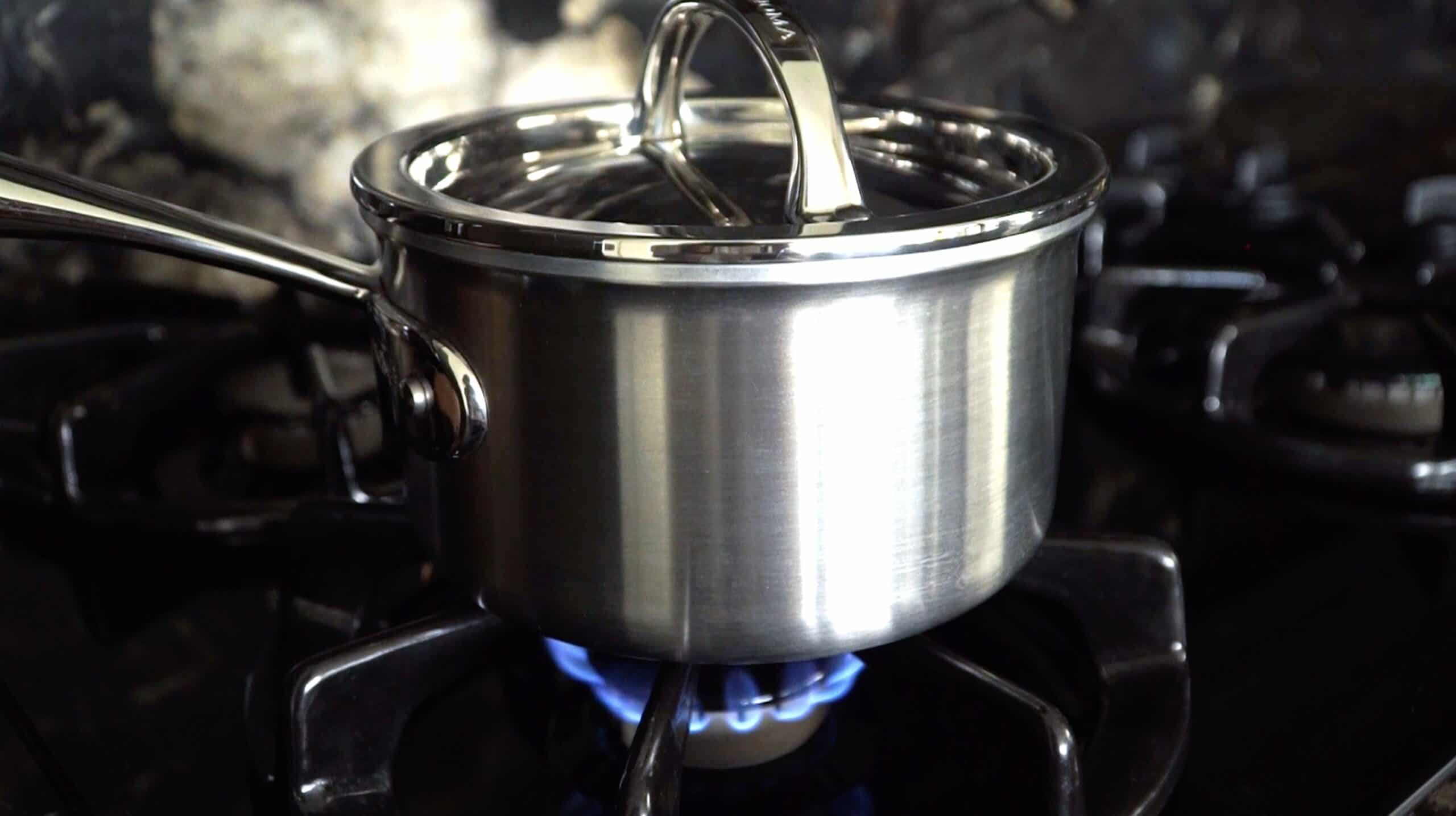Stovetop Kratom Brewing Guide
The no-frills way to brew effective, strong kratom tea. The stovetop kratom brew is also the closest we get to a traditional Southeast Asian brew.

Ingredients:
1 kratom tea bag (3 grams)
8-12 oz (240-360 ml) cold, filtered water
Optional: 1 tsp lemon or lime juice
Optional: 1-2 tsp sweetener
Equipment:
Small saucepan (about 1 qt)
Ingredients:
2 kratom tea bags (6 grams)
16-24 oz (480-720 ml) cold, filtered water
Optional: 2 tsp lemon or lime juice
Optional: 2-4 tsp sweetener
Equipment:
Small saucepan (at least 1 qt)
Ingredients:
3 kratom tea bags (9 grams)
24-36 oz (720-1080 ml) cold, filtered water
Optional: 1 tbsp lemon or lime juice
Optional: 1-2 tbsp sweetener
Equipment:
Medium saucepan (about 2 qts)
Ingredients:
14 kratom tea bags (42 grams)
14.5 cups cold, filtered water
Optional: Juice of 1 lemon or 2 limes
Optional: 1/4-2/3 cup sweetener
Equipment:
Medium stockpot (about 4 qts)
Get more specific tips and instructions on how to batch brew in our large batch kratom tea brewing guide.
Brewing kratom tea on the stove in a saucepan allows for the ultimate level of customization of your brew strength and flavor. This brew method is best for when you’re at home and have a bit of time to spare, but you can also rig up a stovetop brew with a camp stove or over a fire while on a trip.
Instructions
1. Prep: Add water, tea bags, and lemon juice (if using) to your saucepan or pot.
2. Steep Tea: Bring water to a boil, then immediately reduce to a low simmer. Watch your tea closely in the first few minutes of brewing to make sure it doesn’t boil over.
To make more-concentrated tea, keep the pot uncovered while simmering. Be careful not to let all the water boil off if you are just making 1 or 2 servings. To make a less-concentrated tea, cover your pot.
Simmer for 15-25 minutes. The longer you brew, the stronger (and slightly more bitter) your tea will be.
3. Strain: Turn off the heat. Strain out tea bags using a slotted spoon or mesh strainer.
4. Sweeten: You can add sweetener to the entire pot, or remove individual servings and sweeten them separately.
6. Serve: Transfer your tea to a mug or to a heat-safe glass with ice to make iced tea.
7. Store leftovers: If you are batch brewing or have leftover tea, transfer it to a heat-safe jar or another container and seal it tightly. Store tea in the fridge for up to one week. Drink chilled from fridge or reheat.
6. Optional Rebrew: You can typically rebrew your kratom tea bags to make a slightly weaker second pot of tea. The strength of this second brew will depend upon the length and strength of your initial brew.

Stovetop Brewing FAQ
Q: Why use the stovetop method for brewing crushed-leaf kratom?
A: By brewing on the stove, you can maintain a high temperature throughout your entire brew. This allows for a more thorough extraction of kratom’s alkaloids from the leaves, resulting in a stronger, more effective tea. It also closely mimics the traditional brewing method used in Southeast Asia.
Q: My leftover tea turned cloudy. Is it still safe to drink?
A: Yes! Certain compounds in kratom tea naturally precipitate when the tea’s temperature decreases. Chilled kratom is typically a bit cloudy. Don’t worry, it still won’t be gritty like a slurry!
If your leftover tea has a weird taste, smell, or coloration, you should dispose of it. It may be contaminated with bacteria or mold.
Q: Can I adjust the strength of my kratom tea when brewing on the stovetop?
A: Absolutely. You can alter the strength by playing with a few different variables:
- Longer simmering produces a stronger and more bitter tea, while shorter times yield a milder flavor.
- Leaving the cover off the pot allows water to evaporate, so your tea will be more concentrated. Each cup of tea will be slightly stronger.
- Adding acidic ingredients, like lemon juice, lime juice, or apple cider vinegar, can potentially improve the extraction of certain alkaloids from the kratom leaves.
Q: How do I make my stovetop tea less bitter?
A: To reduce bitterness, try simmering for a shorter period, using more water, adding sweeteners and flavorings, or drinking your tea on ice. Covering the pot while you simmer your tea can also help contain the herbal essences of your added ingredients, making the tea more flavorful.
Q: What’s the best way to strain tea bags or loose-leaf kratom tea from the pot?
A: Using a slotted spoon or metal strainer works well to remove tea bags. For loose leaf kratom, a cheesecloth or coffee filter can provide a clear brew. For your safety, allow your tea to cool off a bit before pouring it out of the pot.
For more info on batch brewing with loose leaf, read our guide on how to brew large batch kratom tea.
Q: Is it possible to make iced kratom tea using the stovetop method?
A: Sure! After brewing your tea, you can either add it to a glass with ice, or transfer it to a jar to let it chill in the fridge. You can also experiment with making cold-brew kratom tea.
Q: What’s the optimal heat setting for simmering kratom tea on the stove?
A: After bringing the water to a boil, reduce the heat to a low simmer. This gentle heat level extracts the alkaloids effectively without boiling off too much water.
Q: How do I prevent the tea from boiling over?
A: Keep the heat at a low simmer and use a pot that’s large enough to contain the water and tea without being too full. Watching the pot, especially at the beginning of simmering, can help prevent spills. If your tea starts to bubble or foam, turn down the heat a bit and give it a stir.
Q: What type of pot is best for stovetop kratom tea brewing?
A: A stainless steel or ceramic pot is ideal for brewing kratom tea on the stove. These materials distribute heat evenly, preventing hotspots that could lead to over-extraction or burning of the leaves.
Avoid non-stick pots and aluminum pots if possible. The non-stick coating has the potential to interact with the tea under high heat. Aluminum pots can react with the acidity from lemon or lime juice, potentially altering the flavor of your tea.
Q: Is it safe to leave the stove unattended while brewing kratom tea?
A: It’s always best to stay nearby while your tea is simmering. This allows you to monitor the brew and adjust the heat if necessary to prevent boiling over.